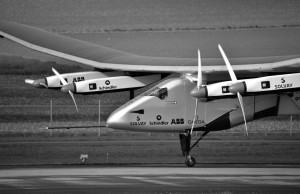
Solar Impulse II. Photo by Milko Vuille. from Wikimedia Commons
By Thaddeus Rumple
You can use power from the sun, even when the sun is not shining, with storage options today. Furthermore, you can use it for some pretty intensive applications, such as powering an aircraft in flight. We saw that when Solar Impulse HB-SIA flew well into the night as it crossed the United States powered entirely by solar cells.
Solar Impulse HB-SIB (Solar Impulse II), the second aircraft in its solar-powered series, is about to go on a round-the-world flight entirely powered by sunlight. The 269.5 square meters of solar cells, mounted on its wings, will power four electric motors and store enough power during the day to keep it going all night. This means that it can fly continually, all day and all night, for days on end.
As Green Energy Times goes to press, the Solar Impulse is in Dubai, the beginning and end point of its flight. It is expected to begin its flight in late February or early March. Since it can fly continually, it will be aloft for days at a time, but its slow cruising speed of about 56 miles per hour, means that the journey will take a long time. It will fly with five stops, to allow changes of pilots. The individual legs of the journey will last from three to four days each.
The aircraft is nothing if not impressive. Its wingspan is 236 feet. By comparison, the greatest wingspan on any Boeing 747 model is 224 feet 7 inches, and the eight-engine B-36, the largest combat aircraft ever built, has a wingspan of 230 feet. One aircraft with a larger wingspan than the Solar Impulse II was the Hughes H-4 Hercules, or “Spruce Goose,” with its 320 feet. One other difference is that the Solar Impulse II only weighs 5,100 pounds, fully loaded.
Four lithium-ion batteries each provide 13kW to the four electric motors. Its maximum speed is 87.5 miles per hour, and its takeoff speed is 22 miles per hour. Yes, you read that right, 22 mph.
Solar Impulse II is set to cruise at altitudes above any weather that might block the sunlight. The cabin is unpressurized to keep weight down, so the pilot will be provided with oxygen. There is an autopilot, so the pilot can sleep a bit. Still, we might imagine this will not be a particularly comfortable flight. We might think of it the next time we get into a jumbo-jet powered by aviation fuel and want to complain about the flight.








Leave a Reply